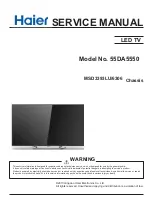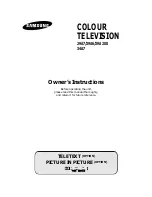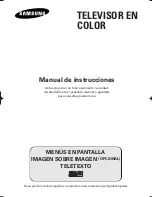
3DQDVRQLF
7
Chapter
1
Common Circuits
3.1. Acoustic Feedback Processing
The audio signals, output from the Multi-standard
Sound Processor IC2101 pins 24 and 25 (located on
the E-Board) are fed via transistors Q2102 and Q2103
via connectors E10 / Z4 pin 1 and 2 to the Acoustic
Feedback (AFB) circuit, made up of IC2201 and
IC2221, located on the Z-Board. Here the processing
previously mentioned is performed before the audio
signals are output from the AFB circuit and fedback
to the E-Board via connectors Z4 and E10 pin 5 and
6, and to the input of the audio amplifier IC251.
A supply voltage of 8V [
12V on Euro 4D] is applied to
the VCC inputs of IC2221 and IC2201. This 8V [
12V
on Euro 4D] supply is also used to bias the op-amps
of both ICs, the biasing of these op-amps being set to
1/2 Vcc by the op-amps at pins 12, 13 and 14 of both
IC2221 and IC2201. To perform the processing
already mentioned, two AN6554 devices are used.
The AN6554 is a quadruple op-amp device used to
perform AFB, with IC2201 processing the right
channel audio signal and IC2221 processing the left
channel audio signal.
At the same time the left microphone signal input via
connector Z5 pin 2, is fed to IC2221 pin 2 via C2221
and R2221. The signal is buffered and output from pin
1 of IC2221. Here the signal is split into two paths.
The first sees the microphone signal being fed via a
high-pass filter, consisting of capacitors C2231,
C2232 and resistor R2224. The signal is then input via
pin 5 to the emitter follower configured op-amp where
the signal is buffered and output via pin 7 and resistor
R2227. Here the signal is added to the signal from the
second path fed via resistors R2235 and R2225. After
this signal conditioning of the left microphone signal,
which is required to ensure a stabilised negative
feedback, the added signals are then fed to pin 9 of
IC2221.
Here this
negative feedback
of
the
microphone signal is applied to the left speaker audio
signal, which is fed from the E-Board to the Z-Board
via connector Z4 pin 1. From connector Z4 pin 1, the
left speaker audio signal is fed via de-coupling
capacitor C2226, before being fed via a bass boost
circuit in the form of an RC network, made up of the
following components: capacitors C2227, C2228 and
resistors R2233, R2230, R2231 and R2232.
From this RC network, the left audio speaker signal
is input via pin 10 of IC2221. Here the feedback
microphone signal input at pin 9 and the left speaker
audio signal input at pin 10 are combined. This results
in a flat frequency response of the audio signal being
output from pin 8 of IC2221, providing a crisper,
clearer sound for the user. This audio output from pin
8 of IC2221 is then fed to pin 5 of connector Z4, where
the audio signal is fed back to the E-Board via
connector E10. Once the left speaker audio signal is
on the E-Board, the signal is fed to the audio output
IC IC251.
Likewise the right microphone signal input via
connector Z2 pin 1, is fed to IC2201 pin 2 via C2201
and R2201. The signal is buffered and output from pin
1 of IC2201, where the signal is split into two paths.
The first sees the microphone signal being fed via the
high-pass filter, consisting of capacitors C2211,
C2212 and resistor R2204. The signal is then input to
pin 5 where the signal is buffered and output via pin
7 and resistor R2207. Here the signal is added to the
signal from the second path fed via resistors R2215
and R2205. After this signal conditioning of the right
microphone signal, the added signals are then fed to
pin 9 of IC2201. This negative feedback of the
microphone signal is applied to the right speaker
audio signal, which is fed from the E-Board to the
Z-Board via connector Z4 pin 2. From connector Z4
pin 2, the right speaker audio signal is fed via
de-coupling capacitor C2206, before being fed via the
bass boost circuit, made up of capacitors C2207,
C2208 and resistors R2213, R2210, R2211 and
R2212.
From this RC network, the right audio speaker signal
is input via pin 10 of IC2201. Here the feedback
microphone signal input at pin 9 and the right speaker
audio signal input at pin 10 are combined. The flat
frequency response of the audio signal is output from
pin 8 of IC2201. This audio output from pin 8 of IC2201
is then fed to pin 6 of connector Z4, where the audio
signal is fed back to the E-Board via connector E10.
Once the right speaker audio signal is on the E-Board,
the signal is fed to the audio output IC IC251.
Содержание EURO 4 Chassis
Страница 24: ...3DQDVRQLF 24 ...
Страница 26: ...3DQDVRQLF 26 TV STANDARDS ...
Страница 93: ...3DQDVRQLF 10 ...
Страница 97: ...3DQDVRQLF 14 Chapter 2 EURO 4 Supplement P Board DAF Circuit ...
Страница 101: ...3DQDVRQLF 18 ...
Страница 121: ...3DQDVRQLF 38 Chapter 3 EURO 4H Supplement Y Board Schematic ...
Страница 124: ...3DQDVRQLF 41 ...
















































